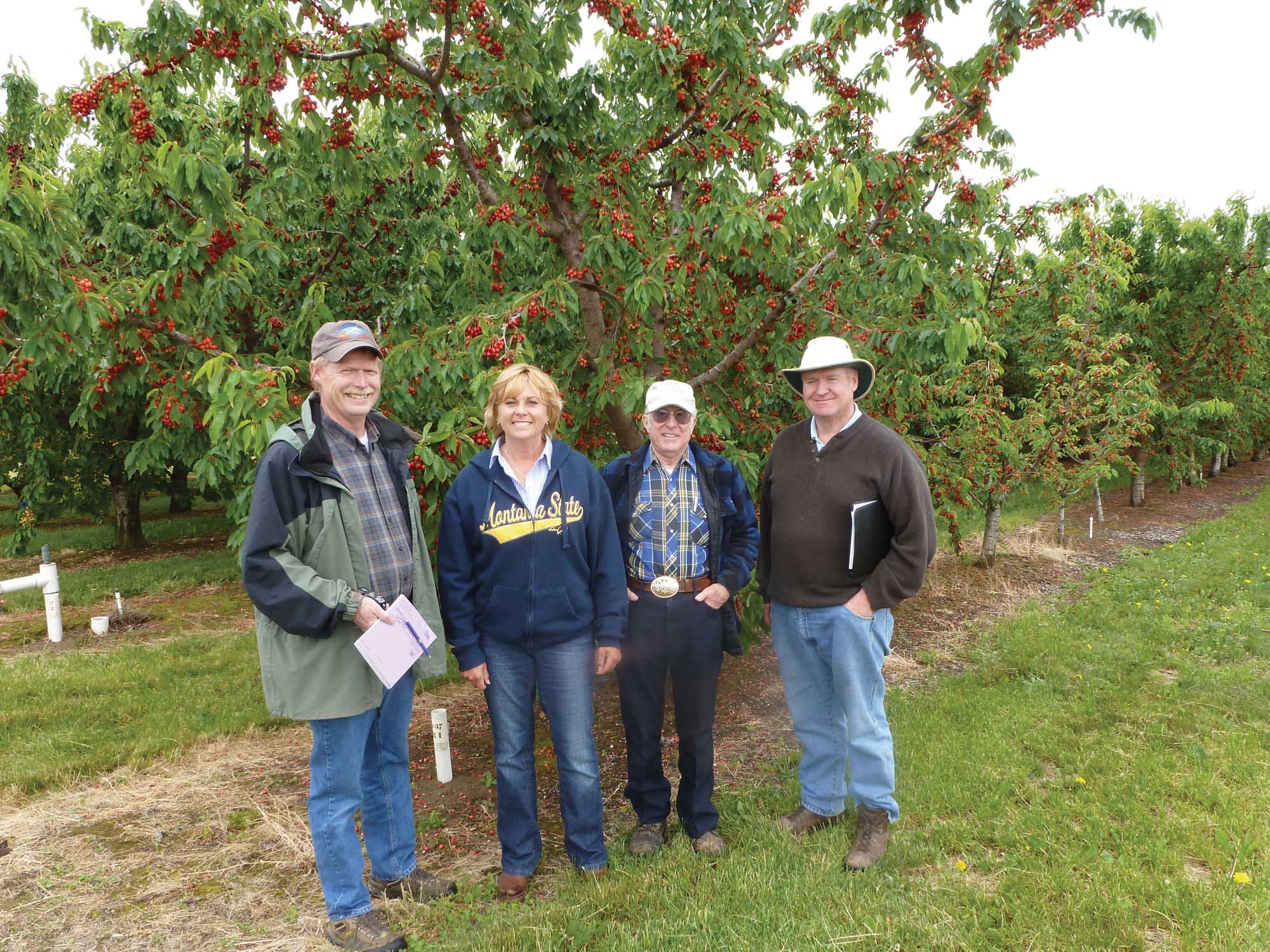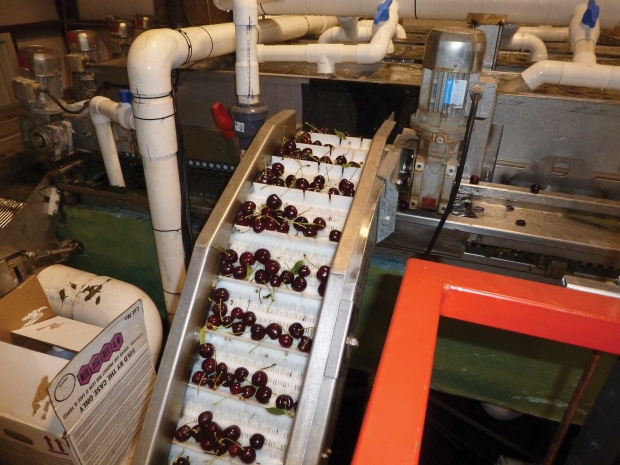
For many years, Montana sweet cherries were marketed as the tail end of the Washington state crop, not having much of an identity of their own. But more recently, growers in Montana have worked to project a better image of what they think are better cherries and to get a better price for them.
“For the last five years, we’ve been trying to brand Montana fruit,” said Ken Edgington, a member of the board of directors and secretary of Flathead Lake Cherry Growers Association. “We produce the latest cherries in the United States, but they’ve always been identified with the Northwest and not Montana specifically.”
The Flathead Lake association is a cooperative of about 70 growers. Since 1999, they’ve been shipping most of their fruit by truck to Monson Fruit Company in Selah, Washington, for packing and then for sale through Domex Superfresh Growers.
“We have a contract to send at least 80 percent of our production to Monson,” Edgington said.
Domex does a good job of getting the cherries into wholesale distribution in large supermarkets across the country, he said, but rural and small-town Montana itself was missing out on access to its own cherries.
So the co-op began looking for a way to identify Montana fruit and also find a partner that could distribute some of it back in Montana. They found both.
Monson now packs a special package, called Montana Premium, in a special box containing 10 1/2-row and larger cherries. Not only does Domex distribute them, but the Flathead Lake Cherry Growers found a new partner in Charlie’s Produce, of Spokane, Washington.
Alex Plummer, general manager of Charlie’s, said Charlie’s distributes food products to restaurants and retail establishments, including those in Montana. In 2013, Charlie’s sponsored a display competition among the stores it serves, creating great visibility for the new Montana Premium package.
Pristine image
“Montana has a nice image,” Edgington said. Domex is using that Big Sky Country image of Glacier National Park and Flathead Lake, pure mountain creek water, and the special climate, as well as the fact they are produced by a grower cooperative, as part of its marketing program.
The production area itself, Flathead Lake, and its location near Glacier, makes it a popular tourist attraction and resort, and local growers are selling more at roadside stands.
Traditionally, growers in the area grew Lambert, which Edgington describes as “a really fine tasting variety that doesn’t travel well.” In 1989, unseasonal temperatures almost destroyed the industry, killing more than half the trees, but growers replanted, looking for later, firmer varieties. They planted mostly Lapins.
“We don’t tell our growers what to grow,” Edgington said. “But we are encouraging them to plant varieties that are larger, firmer, sweeter, and that travel well and pack out nice.” Today, Lapins makes up 64 percent of the cherries the co-op has to sell, he said, with Lambert still number two at 29 percent. The remaining seven percent is made up of Skeena, Sweetheart, Rainier, and Bing, with some growers trying Kootenay and Attika.
Late market
As growers in Washington have been planting later varieties to capture a later market, they have been invading territory once conceded to Montana. So Montana growers have also been shifting to later varieties to keep the tradition of producing cherries worth the wait.
Cherry harvest in Montana starts around July 20 with Lambert and continues with Lapins in early August and Skeena a week later. Sweetheart, the latest variety, picks around August 15. The goal is to have even later cherries to sell toward the end of August.
Dr. Pat McGlynn, a Montana State University horticulturist who worked with the cherry growers on variety trials, said the growers are trying to stay in a “sweet spot” in the production period—“just after Washington but not so late that the workers all leave to pick apples in Washington.”
As Washington plants at higher elevations to produce later cherries, the Flathead Lake growers haven’t been able to do that, so they need to find later varieties.
In the last few years, however, she sees a spirit of renewal and a lot of enthusiasm among Montana growers as they experiment with later varieties on new training systems to meet market demands for larger fruit that is available all the way to Labor Day.
The association now has its own website, www.montanacherries.com, which Edgington maintains, containing promotional materials and videos aimed at consumers and produce buyers. The site identifies grower-members who have roadside stands and will ship smaller orders or will allow retailers to pick up cherries at their orchards.
Cherries for export

In recent years, a local packer has been playing a growing role. That is Glacier Fresh, which has developed its own method of capitalizing on high quality fruit coming to market at the end of the sweet cherry season.
“We want to be known as Montana cherries and make the best that we can of that,” said Cody Herring, who runs Glacier Fresh Orchards. His mother, Marcia Zimmerman, bought the orchards in 2001, and he began managing them. Both were from Texas, with no background in fruit production. In 2005, after a few years being part of the Flathead Lake cooperative, they began packing their own cherries. “Three years later, we began packing for others,” Herring said.
“We can grow a 20° Brix cherry year after year,” Herring said. “It’s a good cherry climate.”
In 2012, they upgraded their packing line with an optical sizer.
Last year, Glacier Fresh packed cherries from about 115 acres, 55 of their own and another 60 for 15 other growers, and sold them through a collaboration that includes several grower-packer-shippers in Canada. They pack to a standard of size 9- and 8 1/2-row cherries, and sell all over the world.
Consumers in Europe and Asia will pay well for cherries, but only want the biggest and sweetest, Herring said. The group sold 600,000 boxes last year, he said.
Glacier Fresh cherries are trucked six hours north to Calgary, where many of them are loaded onto planes for shipment. He works through a marketer based in Oliver, British Columbia, Canada, which exports fruit by air or sea.
Air-freighted cherries that were in the orchards in Flathead Lake, Montana, can be in markets in Italy, Germany, England, or China within a day.
Washington growers have, by and large, much larger orchards than Herring, and Glacier Fresh, at 55 acres, is much larger than most around Flathead Lake. In that way, Herring feels comfortable among the Canadian growers, who are usually smaller as well.
Making money on a small acreage, he said, requires attention to the kind of detail that can put fruit into premium markets. Part of the task is careful pruning and thinning to get large, sweet cherries.
What about small cherries? Last year, Herring said, he was able to sell 100,000 pounds of small cherries to a local distillery that makes cherry brandy.
Buyers aren’t much interested in Lamberts, he’s found.
He thinks a Canadian variety called Kootenay, which was discovered in Creston, British Columbia, is promising. He planted some in 2010. It’s as late as Sweetheart, but the fruit is larger. It is firm with a high sugar content and has a long, green stem. The variety has not been popular in Washington because it doesn’t tolerate intense heat, but he thinks it could be a good fit for Montana.
Late-season prices
Dale Nelson, the past president of the Flathead Lake association, manages a new orchard of Sweetheart cherries on a farm owned by Dale Webster. The orchard was designed with advice from Monson field personnel.
“We tore out an old Lambert orchard, fenced the area to keep out deer, elk, and sometimes bear, and planted the high density orchard with trees seven feet apart and rows 14 feet,” he said.
“We kept the trees cool until planting, installed trickle irrigation, gave them fertilizer from day one, and began pruning right away to develop a two-leader tree,” he explained.
“We have this orchard on the latest growing site in North America. We think we’ll harvest August 20 to 25. We’ve seen the price of cherries go up $1 a pound in the week after the season ends. A dozen growers here are trying to harvest in that season.” •
Cherries by the lake
Flathead Lake in northwest Montana, at 450 feet deep and 28 miles long, is the largest fresh-water lake west of the Mississippi and is surrounded by almost 1,000 acres of cherries. Montana yields run about five tons per acre, so it produces 5 to 10 million pounds—a drop in the bucket compared to Washington’s production of 320 million.
The lake has a moderating influence on the climate, so spring freezes have not been a problem. Bruce Johnson, president of Flathead Lake Growers, said a disastrous freeze in 1989 was caused by a February spell of warm weather followed by a rapid return to frigid temperatures, which killed about half the trees in the region.
Area growers get some additional help promoting and marketing their crop from the Montana Cherry Advisory Committee, which puts up some money to support research and special projects. Most growers are GlobalGAP certified, a direct result of efforts by the committee to get growers certified.
Part of the money goes to a state-funded pest management area that monitors for cherry fruit fly and spotted wing drosophila. The Montana Department of Agriculture collects a half-cent a pound on Montana-produced sweet cherries to support that program and to support local advertising and agritourism.






Where do you get your data for the total production of cherries in Montana of almost 1000 acres? Per their contract you mentioned, 80% would be 800 acres. 800 acres at 5 ton per acre would be 8 million pounds. They sent 2 million pounds to Monson Fruit this year.
I sold my vineyard and moved back to Montana. I still have my air blast Sprayer. Anybody need one. Its 10 nozzle 110 gallon tank. Need at least 45 hp. Have pictures, just sprayed Today, working fine.
We wish you good luck selling your sprayer, Steve. A great way to reach growers in your region is with a classified ad in our print magazine. Check this page for information on placing a classified ad: https://www.goodfruit.com/advertise-with-us/